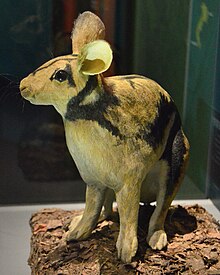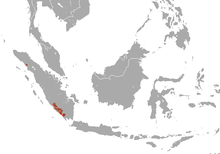Sumatran striped rabbit
| Sumatran striped rabbit[1] | |
|---|---|

| |
| A model of an adult | |
| Scientific classification | |
| Kingdom: | Animalia |
| Phylum: | Chordata |
| Class: | Mammalia |
| Order: | Lagomorpha |
| Family: | Leporidae |
| Genus: | Nesolagus |
| Species: | N. netscheri
|
| Binomial name | |
| Nesolagus netscheri (Schlegel, 1880)
| |

| |
| Sumatran striped rabbit range | |
The Sumatran striped rabbit (Nesolagus netscheri), also known as the Sumatra short-eared rabbit or Sumatran rabbit, is a rabbit found only in forests in the Barisan Mountains in western Sumatra, Indonesia, and surrounding areas. It is threatened by habitat loss, leading the IUCN to rate it as Vulnerable.[2]
Related species[]
This rabbit was the sole representative of the genus Nesolagus until the Annamite striped rabbit was discovered in the Annamite Mountains between Laos and Vietnam.
Description[]
The Sumatran striped rabbit is usually about 40 cm (1 ft, 4 in) long, with tails 17mm long.[3] It is black with brown stripes, with a red tail and rump, and the underside is white. Their fur is soft and dense, overlaid by longer, harsher hairs.[4]
Biology[]
As the species is rare, nocturnal and found only in remote forests, little is known about it. The local people do not have a name for the Sumatran rabbit because they are not aware that the species even exists.[5] Indeed, the vernacular terminology for "rabbit" is either borrowed from other languages to refer to foreign species of rabbit (arnab from the Arabic أرنب[6] and kelinci from the Dutch word konijntje[7]) or not distinguished to that of felines (kucing e.g. kucing belanda or kucing tapai).[8]
The rabbit rests in the burrows of other animals. It usually eats the stalk and leaves of understory plants, but captive rabbits eat grain, and tropical fruits.[9]
Habitat and range[]
This species is said to be endemic and is native to the Barisan Mountains in Sumatra, Indonesia in north-west Sumatra. It has also been found in west and southwest Sumatra, and there is one record from Gunung Leuser National Park.[5] It lives in forests at altitudes of 600–1600 metres above sea level. It is one of the few lagomorphs that chooses to live in the dense rainforest. The Sumatran rabbit also prefers to live more specifically in montane forests with volcanic soil.[5]
Threats[]
The forests which the species inhabits are being cleared more and more for timber, tea and coffee plantations, and human inhabitation. The unusual surge of immigrants coming from the Indonesian island of Java has also increased the rate of disappearance of the species' habitat.[5]
Observation in the wild[]
Following a sighting in 1972, the Sumatran striped rabbit went unreported until an individual rabbit was photographed in 2000.[2] Since then there have been three reports of this species, all from the Bukit Barisan Selatan National Park: In January 2007 one was photographed with a camera trap,[10][11] in September 2008 one was photographed by a WWF scientist,[12] and in June 2009 one was observed.[13] In 2011 examples were photographed in the wild by a scientific team using camera traps in Bukit Barisan Seletan and Kerinci Seblat National Parks.[14]
Conservation[]
The species is listed as Vulnerable by the IUCN. It is rarely seen and thought to be uncommon in its habitat; population size is unknown. Its rarity may be the result of deforestation and habitat loss. Attempts to start a conservation plan were not funded due to lack of reliable distribution and abundance information.[2]
References[]
- ^ Hoffman, R.S.; Smith, A.T. (2005). "Order Lagomorpha". In Wilson, D.E.; Reeder, D.M (eds.). Mammal Species of the World: A Taxonomic and Geographic Reference (3rd ed.). Johns Hopkins University Press. p. 205. ISBN 978-0-8018-8221-0. OCLC 62265494.
- ^ Jump up to: a b c d McCarthy, J.; Holden, J.; Martyr, D. & McCarthy, K. (2019). "Nesolagus netscheri". IUCN Red List of Threatened Species. 2019: e.T14662A45178557. doi:10.2305/IUCN.UK.2019-2.RLTS.T14662A45178557.en. Retrieved 19 December 2019. Listed as Vulnerable B1ab(i,ii,iii,iv,v) ver 3.1
- ^ Macdonald, David (1993). The Encyclopedia of Mammals. Fact on File, Inc. ISBN 0-87196-871-1.
- ^ Nowak, Ronald M. (1999). Walker's Mammals of the World (Sixth ed.). Baltimore, Maryland: Johns Hopkins University Press. p. 1723. ISBN 9780801857898. Retrieved 15 November 2012.
- ^ Jump up to: a b c d Flux, J. E. C. (1990). "The Sumatran Rabbit Nesolagus netscheri". Rabbits, Hares, and Pikas: Status Survey and Conservation Action Plan. Gland, Switzerland: IUCN.
- ^ "arnab". World Loanword Database (WOLD). Max Planck Digital Library. Retrieved 10 October 2017.
- ^ "kelinci". World Loanword Database (WOLD). Max Planck Digital Library. Retrieved 10 October 2017.
- ^ Wilkinson, Richard James (1901). "kuching". A Malay-English dictionary. Hong Kong: Kelly & Walsh, limited. p. 545.
 This article incorporates text from this source, which is in the public domain.
This article incorporates text from this source, which is in the public domain.
- ^ Gorog, Antonia. "Animal Diversity Web: Nesolagus netscheri". University of Michigan Museum of Zoology. Retrieved 2007-04-05.
- ^ "Striped rabbit spotted in Sumatra". BBC News. 2007-04-05. Retrieved 2007-04-05.
- ^ "World's rarest rabbit captured on film in Indonesian rainforest". Mongabay.com. 2007-04-14. Retrieved 2012-06-17.
- ^ WWF Save Sumatra (2009) Rare rabbit species directly photographed. Retrieved January 3, 2011.
- ^ Dinets, V. (2010). "Observation of Sumatran striped rabbit (Nesolagus nescheri) in the wild". Mammalia. 74: 1. doi:10.1515/mamm.2009.074. S2CID 83737097.
- ^ McCarthy, Jennifer L.; Fuller, Todd K.; McCarthy, Kyle P.; Wibisono, Hariyo T.; Livolsi, Mark C. (July 2012). "Using camera trap photos and direct sightings to identify possible refugia for the Vulnerable Sumatran striped rabbit Nesolagus netscheri". Oryx. Fauna & Flora International. 46 (3): 438–441. doi:10.1017/S0030605312000051.
- IUCN Red List data deficient species
- Rabbits and hares
- Mammals of Asia
- Mammals of Indonesia
- EDGE species
- Fauna of Sumatra
- Mammals described in 1880
